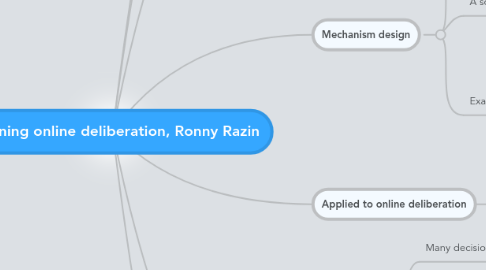
1. about
1.1. researcher in London School of Economics
2. title
2.1. What can we learn from mechanism design & auction theory
3. motivation
3.1. deliberation in large-groups
3.1.1. what's the problem?
3.1.1.1. congestion
3.1.1.2. participation
3.1.1.2.1. small number of leading dominant people
3.1.1.3. aggregation of preferences
3.1.1.3.1. the solution should aggregate the preferences of most participants
3.1.1.3.2. better decision aggregates the preferences of more people
3.1.1.4. Information aggregation/crowd sourcing
3.1.2. what's the benefit
3.1.2.1. encourage more people to participate & be involved
3.1.3. understand
3.1.3.1. Small vs large
3.1.3.2. Offline vs online
3.1.3.3. Voting/deliberating
3.1.3.4. Decentralized vs centralized
3.2. mechanism design
3.2.1. Economy has tools & methodology to talk about these things
3.2.1.1. Game theory
3.2.1.1.1. a tool to understand behavior
3.2.2. Mechanism design is building the game that yields the best solutions
3.3. agenda
3.3.1. Explain mechanism design
3.3.2. Examples that relate to online deliberation
3.3.3. Intuitive & simple solutions
3.3.3.1. vote budgets
3.3.3.2. storable votes
3.3.3.3. creating endogenous trade-offs to internalize externalities
3.3.3.3.1. make peopl understand the trade-offs
4. Mechanism design
4.1. structure
4.1.1. The settings
4.1.1.1. set of players, outcomes
4.1.2. What do the players want to achieve
4.1.3. The solution
4.1.3.1. A mechanism/game for which the predicted outcome is the optimal solution
4.2. A social wellfare function
4.3. Examples of successful designs
4.3.1. Auction theory & practice
4.3.1.1. eg
4.3.1.1.1. Cellular frequencies
4.3.1.1.2. B2B auctions
4.3.1.1.3. Electricity markets
4.3.2. Market design
4.3.2.1. School admissions
4.3.2.2. Market for organs
5. Applied to online deliberation
5.1. The settings
5.1.1. We the ppl, need to decide what to do
5.2. What we want from this
5.2.1. Information aggregagion
5.2.2. Preferences aggregation
5.2.3. Legitimacy
5.2.4. Clarity
5.2.5. Participation
5.3. Solution
5.3.1. Find the optimal design for online platform
6. Examples
6.1. Many decisions - room for coordination
6.1.1. problem
6.1.1.1. each participant cares differently about different decisions
6.1.1.1.1. preferences
6.1.1.2. what do we want to happen?
6.1.1.2.1. how to aggregate preferences
6.1.1.3. see diagrams in slides
6.1.1.4. small groups will probably get there
6.1.1.5. simple voting won't get the result we think aggregat preferences right
6.1.1.5.1. doesn't aggregate how much people care for the issues
6.1.2. Solution mechanism: vote budget
6.1.2.1. each participant gets a pool of ballots
6.1.2.1.1. some will put just 1 ballot, others that care more will put more
6.2. Decisions over time (repeating)
6.2.1. we make similar decisions over time
6.2.2. Solution: storable votes
6.2.2.1. Each individual is allocated stock of votes, in each period
6.2.2.2. Save the votes for later periods
6.2.2.3. Ppl will use more votes in periods in which the care more
6.2.2.4. Can trade votes between them
6.3. Congestion
6.3.1. Problem
6.3.1.1. too many ppl talk
6.3.1.2. Too much information
6.3.1.3. Discussion not clear
6.3.2. Issues at stake
6.3.2.1. Information aggregation
6.3.2.2. Allocation of roles
6.3.3. Solution
6.3.3.1. Moderation
6.3.3.1.1. Centralized moderation
6.3.3.1.2. Decentralized moderation?
6.3.3.2. Give cost to participation & create trade-off
6.3.3.2.1. the more you talk, the less you can vote
